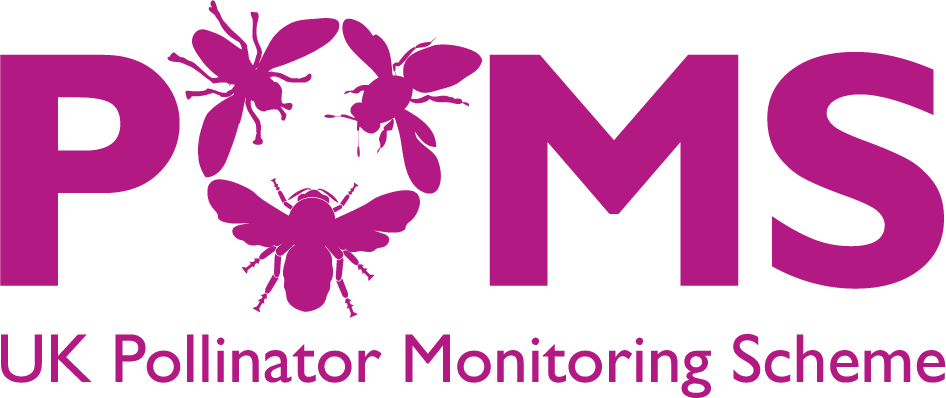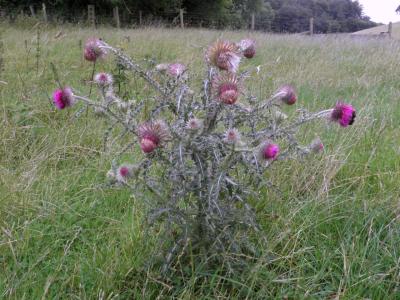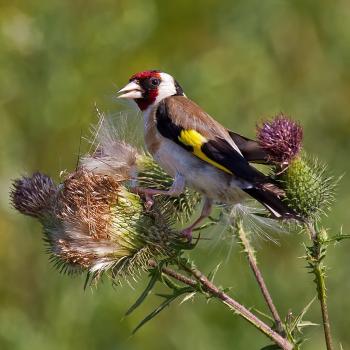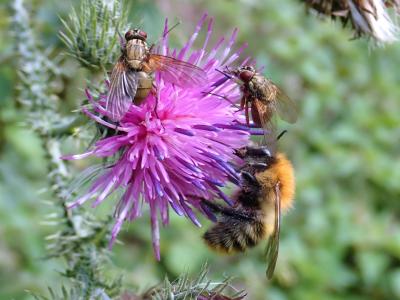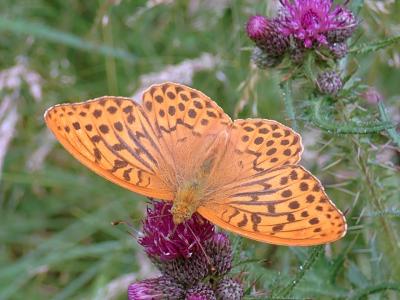Thistles support wildlife from stem to seed
As we move through summer, thistles can be among the most abundant flowers in some areas. That could be from thick beds of Creeping Thistle in wasteland or field margins, or Spear Thistle with its attractive deep purple flowers. In this blog, Rob Jaques, Garden BirdWatch Supporter Development Officer at the British Trust for Ornithology, discusses their variety and value for insects and birds alike.
Though sometimes battled by over-eager gardeners, thistles are culturally important, most notably as an emblem for Scotland and though evidence lacks, some species were used in traditional medicines. There is a range of thistle species which can be encountered in the countryside, with some being habitat-specific while others are generalist. The leaf structure is often used for identification but with some practice, the most common species are quite distinctively shaped, even from a distance. There are also a wide number of species commonly grown in horticulture, and despite not being native, these can be as productive for pollinators as our native species.
|
A particularly spiny clump of Nodding Thistle in one of the PoMS 1 km square survey locations – Martin Harvey |
Though some species begin to flower earlier the majority start in June and July and can be flowering as late as October in common species like Spear Thistle. They can be particularly well visited in the later parts of summer when many other flowers are scarce.
Like other members of the daisy family (Asteraceae), the flower heads are composites made up of many flowers closely clumped together. This means that there is often an abundance of nectar and pollen to be found on a single head, and insects spend longer feeding than they might do otherwise.
Thistles also provide more than just food for pollinators. A number of flies use the plants as homes for their larvae. Bulging lumps on the stems of Creeping Thistles are the creations of Thistle Gall Fly, a striking member of the fruit fly family. Cheilosia, a large genus of hoverflies, has several species whose larvae feed on thistle. Unusual-looking specimens of Marsh Thistle are often host to Cheilosia albipila, whose hungry larvae make the plant grow in a spindly fashion. There is also a wealth of flies, beetles and moths whose young create mines in thistle leaves.
It isn’t only insects benefitting from thistles, however. When seeds begin to develop the seeds, rich with beneficial oils and fats, attract a range of finches, most notably the Goldfinch. Goldfinches move through different seeds in the year as different plant species become available, and thistles (and the closely related burdocks) fill a gap in late summer, between the dandelions of spring and teasles of Autumn. Allow thistle to go to seed in your garden is a great way to watch these birds pay a visit.
|
Goldfinch investigating seeds from a Spear Thistle flower – Andreas Trepte, www.avi-fauna.info |
FIT Counts on Thistle
Thistles attract a wide range of insects, and with over 500 FIT Counts having taken place on thistle, this diversity of pollinators likely attracts surveyors. No one group of insects dominates the results, though small insects make up 35% of the visiting insects counted. It is interesting to compare the results to the closely related and similar-looking knapweeds. For thistles, the various bee groups amount to 20% of the count of insects, while on knapweeds this is 44%. It might be safe to assume that individual flowers of the knapweeds are better suited for bee pollination whereas thistles take a generalist approach.
|
Common Carder bumblebee and two muscid flies (classed as 'other flies' for the purposes of FIT Counts!) – Martin Harvey |
While butterflies only make up a small proportion of the visiting insects, thistles can attract a wide range of species, including some desirable groups such as fritillaries, skippers and Marbled Whites.
|
Silver-washed Fritillary feeding on a Thistle flower – Martin Harvey |
Over 30% of the 8055 insects recorded on thistles are flies. Thistles seem quite popular with flies in the family Empididae, sometimes known as dagger flies. Their long mouth parts are ideal for snaking into the individual flowers.
The British Trust for Ornithology is one of the PoMS partners, and works closely with us to help promote the PoMS surveys alongside the range of wildlife monitoring projects that the BTO leads on itself. For more information on other BTO surveys see the BTO projects page.
